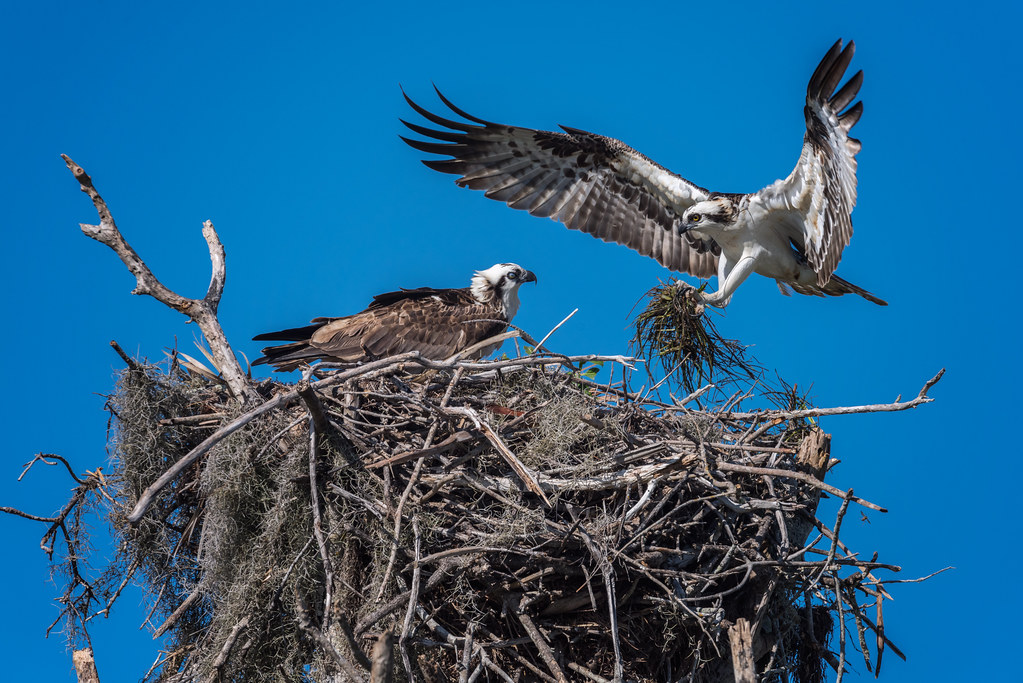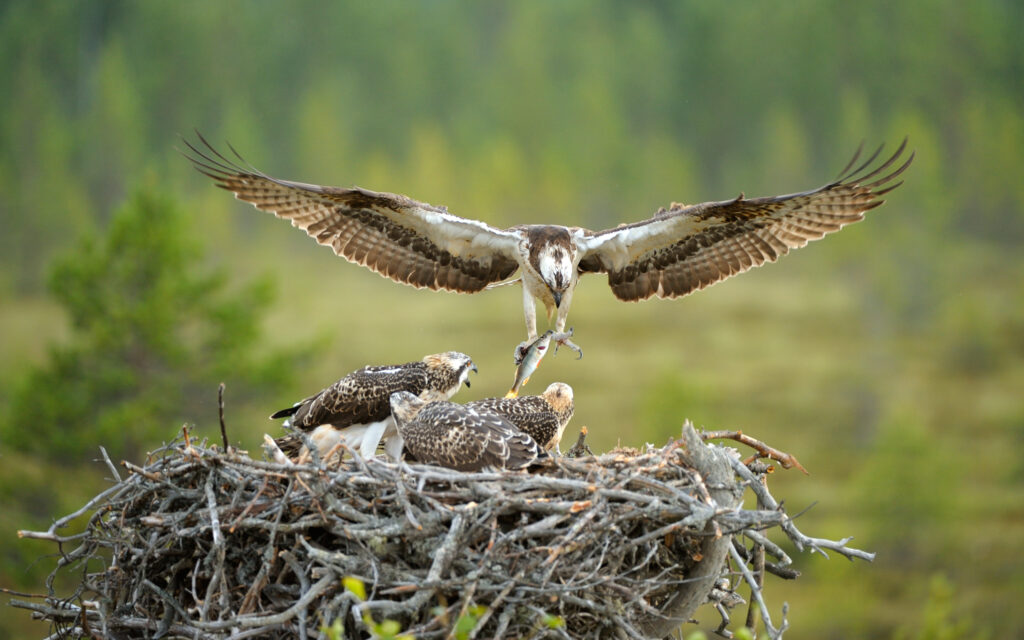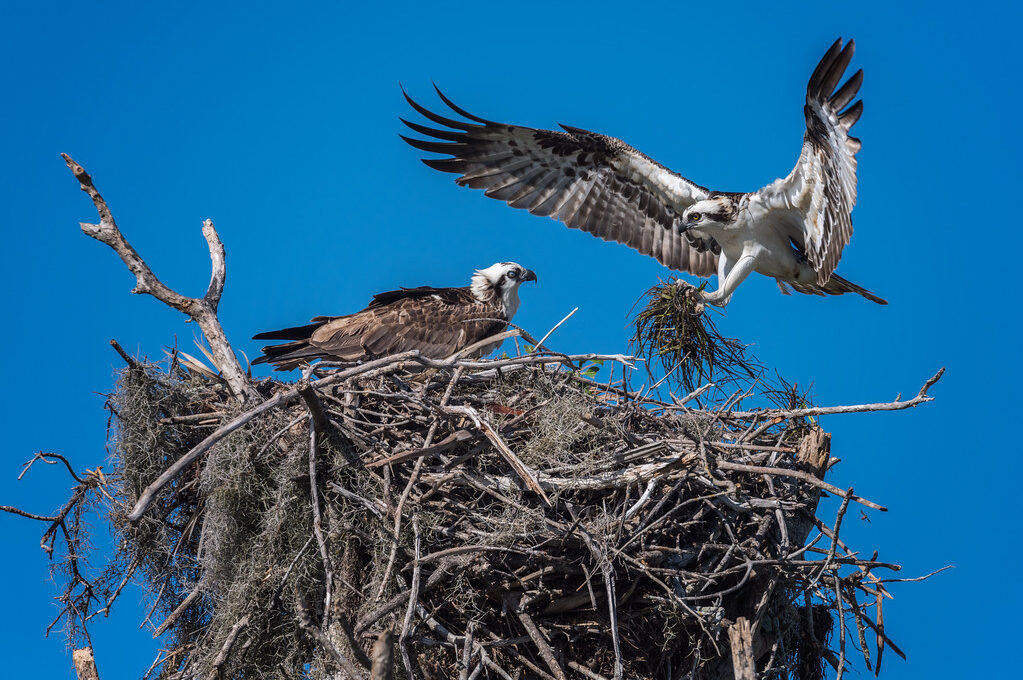One gorgeous March afternoon, I am sitting with my students next to a large pond on Eckerd College’s bayside campus. A gentle breeze is blowing, stirring up sparkles on the pond and wafting through the branches of the oak tree above. A question I’ve just asked about our assigned reading hangs in the air. The shifting patches of light and shadow that fall across us reveal some faces downturned, rereading or searching for a line, and some angled up in thought. More than a few, I notice, are distracted by birds’ antics on the watery expanse beside us. And that’s fine by me; today’s reading is Rachel Carson – and Ms. Carson would want you to pay attention to the birds.
By Amanda Hagood, originally published November 2022
In June 1962, Carson published a series of three articles in The New Yorker that would become Silent Spring, her best known work and a book widely credited for inspiring the modern U.S. environmental movement. Through its analysis of dozens of case studies, Silent Spring presented startling evidence that new synthetic pesticides such as dichloro-diphenyl-trichloroethane (DDT) were accumulating in the ecosystem. DDT was used widely in commercial applications from agriculture to home goods in the years after World War II, and this, Carson argued, could lead to dire consequences for wildlife – and quite possibly for human beings, too.
Silent Spring was an unusual book, mixing a considerable amount of chemistry and biology with poignant imagery and captivating storytelling. Most notable in this sense was the book’s introductory “Fable for Tomorrow,” which imagines an idyllic town struck down by a series of pesticide-related disasters. All were drawn from the pages of real-life reports Carson had read. Silent Spring would prove an electrifying mixture of science and poetry, with readers across the nation clamoring to buy or borrow one of the 100,000 copies sold in just its first week of publication in September of 1962 (since that time, this figure has increased to more than 2,000,000 copies).
Hundreds of editorials in newspapers across the country, together with countless discussions in book clubs, Audubon meetings, and gardening societies, attest to the wide readership and response Silent Spring generated. The popularity of Silent Spring demonstrates its power to focus a wide variety of readers on what might otherwise seem a fairly technical and unengaging subject.
Connecting Readers to the Natural World
Today’s text at Eckerd is not Silent Spring, but Carson’s first book, Under the Sea-Wind, one of the three bestselling volumes about life in the world’s oceans that she published in the 1940s and 1950s. Under the Sea-Wind, followed by The Sea Around Us and The Edge of the Sea, cemented her reputation as a beloved author of – in Look magazine’s words – “science writing for the everyday citizen.” And while we’re not talking about pesticides or bioaccumulation this afternoon, we are tackling the challenge of connecting a general audience to environmental science. To think through this, we’re comparing two different descriptions of an osprey’s nest, one from Under the Sea-Wind and one from the Florida Fish and Wildlife Conservation Commission’s (FWC) online species profile.
“Ospreys build large stick nests,” begins the FWC profile,

…located in the tops of large living or dead trees and on manmade structures such as utility poles, channel markers, and nest platforms. Ospreys have adapted so well to artificial nest sites that the species now nests in areas (e.g. inner cities) once considered unsuitable. Nests are commonly reused for many years.
“I like this one,” comments a student, “because it sticks to the facts. The language is very precise and very economical. And facts are what you need in a field guide.” A few other heads nod in agreement.
“That’s true,” comments another student. “But I think that’s why I actually like the Carson description better. Like in this passage,” she begins to read,
The nest was six feet across at its base and more than half as wide at the top. Its bulk would have overflowed any of the farm carts that were drawn by mules along the dirt roads of the sound country. The two ospreys had repaired the nest and added to it during the years anything they could find washed up on the beaches by the tides. Now practically the whole top of the forty-foot pine served as support for the nest, and the great weight of sticks, branches, and pieces of sod had killed all but a few of the lower branches. (Carson, Under the Sea-Wind, 55-56).
“I like the way it focuses on the two ospreys in particular,” she reflects, “and how they built their nest up year after year and scavenged up new material to add to it. It’s kind of sweet, like they’re working together on their house.”
“But that’s anthropomorphism!” objects another student. “That’s projecting our human feelings and experiences onto other species. You have to be really careful about doing that. We need to be as objective as we can when we’re trying to learn about other animals and the environment.”
“That’s true. But as a writer, don’t you also think she’s trying to get us to care about the ospreys?” another person wonders.
More nods and murmurs as we pause on this point. The dilemma is very real.
Silent Spring and the Noisy Summer
“‘Silent Spring’ is now noisy summer,’ proclaimed New York Times business editor John M. Lee in July of 1962, and how true it was. The “spring without birdsong” that Carson had imagined in her book had given way to a cacophony of public debate, as well as a powerful response from America’s pesticide industry, which launched a full-scale public relations campaign against Carson and her book. At stake were the risks and benefits of new technologies and the regulation of powerful industries. More fundamentally, the book started a national conversation about environmental ethics. “How,” Carson had asked, “could intelligent beings seek to control a few unwanted species by a method that contaminated the entire environment and brought the threat of disease and death even to their own kind?”
These issues would become the subject of a May 1963 report from President Kennedy’s Science Advisory Committee (PSAC) that vindicated Carson’s findings, as well as a Congressional Hearing on pollution that began the same month. On June 2nd, just short of one year after Silent Spring’s first publication, Carson found herself testifying to the Congressional committee. She was introduced by Senator Abraham Ribicoff as “the lady who started all this.” Ribicoff, it is thought, was alluding to Abraham Lincoln’s reputed greeting upon meeting Harriet Beecher Stowe – the “little woman” who wrote a famous book (Uncle Tom’s Cabin) that “started” the Civil War.
The impact of Silent Spring would be most immediately felt in the decade after its publication, where it inspired critical environmental legislation. In 1962, the Federal Insecticide, Fungicide, and Rodenticide Act of 1947 would be amended to include safety considerations in pesticide labeling, and again in 1972 to transfer the regulation of pesticides to the newly formed Environmental Protection Agency (EPA) with a mandate for protecting public and environmental health. The Toxic Substances Control Act of 1976 would then direct the EPA to protect the public from “unreasonable risk of injury to health or the environment,” ultimately leading to the bans or severe restrictions on DDT and five other pesticides discussed in Silent Spring.
Finding the Right Words
“Another thing that’s interesting in this passage is the pine tree,” someone proposes. “See how she talks about how the ‘great weight of sticks, branches, and pieces of sod had killed all but a few of the lower branches’? It shows the impact the ospreys have on the other organisms around them.”

“Yes,” agrees another student. “The FWC profile names some of the specific places where ospreys will build, but the Carson passage describes what that looks like, how it happens.”
The students then share a half-dozen stories about osprey nests on campus, always a popular topic. According to the crowdsourced map on osprey-watch.org – to which several of our students have contributed – our 188-acre campus boasts over 20 nests that have been active in the last few years. Ospreys have built next to our ponds, on top of our athletic field lights, and, most hilariously (or inconveniently, depending on your perspective), at a high point on the peaked roof of our life sciences building, sending a daily barrage of sticks, fishbones, and poop onto the terrace below.
“Well, that’s a really important factor when we’re thinking about the success of osprey populations,” says a student who has participated in a popular osprey survey class here on campus. “They do a great job of adapting to manmade landscapes – like the FWC profile says, ‘utility poles, channel markers, and nest platforms.’ And that’s one reason they are thriving where other birds of prey are struggling.”
“Yes,” I agree. “That, to me, is where the ‘farm carts’ and the ‘dirt track’ in Carson’s passage are interesting. They suggest that humans are a big factor shaping these birds’ habitat.”
As if on cue, an osprey soars into view over the pond, sounding its piping teakettle call across the broad water. Every last head looks up.
Describing an Osprey
The osprey soaring past us is another good example of Silent Spring’s legacy. Like other birds of prey, ospreys felt the impact of DDT in a particularly cruel way: the slow accumulation of DDT in these apex predators’ bodies changed the chemistry of their egg production, making thinner eggshells – and a much higher mortality for chicks. Together with the development of their favored marshy habitats, DDT use led to a 90% decline in osprey populations from the 1950s to the 1970s. But with the regulation of pesticides that followed Silent Spring and a concerted effort to provide nesting platforms, ospreys are back and approaching their pre-DDT populations. The osprey’s conservation story, as Massachusetts Audubon declares, is a “testimony to the power of scientifically-informed environmental activism.” A similar story can be told about other birds we frequently see on this pond, including bald eagles and brown pelicans. In that sense, Silent Spring really did change our world.
We pause to watch the sea hawk before us circle and dive, as good a lesson as any in how to get people engaged in the fight for a healthy and flourishing environment. The osprey’s laser-focused vision and acrobatic high dives are as fantastic as any superhero’s, as inspiring as any words you could dream up to write about them. But because Rachel Carson found the right words to shape a vision of environmental responsibility, we can now see these miracles for ourselves today.
Looking once more at the upturned faces around me, I know this generation comes of age at a time of profound and well-founded ecological anxiety.The shadows of climate change, environmental injustice, and extinction are present in the things they say as well as the things they write in my class. The urge to do something is strong and the need to act is urgent. I like to believe that the things we read and write together give some shape, some necessary space for reflection, to these impulses. Words have the power to inspire, inform, connect and sustain, even when, maybe especially when, the future looks uncertain. And that’s an art we can all practice.
Sixty years on, the importance of Silent Spring endures. Right on, Rachel! And write on, y’all.
Amanda Hagood lives in Gulfport and teaches courses in environmental humanities at Eckerd College. Her work has been published in Interdisciplinary Studies in Literature and the Environment, Salt Creek Journal, and Environmental Humanities. Her favorite hike in Florida is still her first: a visit to Boyd Hill between appointments looking for a place to live. She and her partner were a little dispirited because none of the options were great. “But then we spent one hour walking the trails there and I said, ‘I don’t care where we sleep, can we just be sure to come here every day?’ And they ended up renting a lovely little house just a couple blocks away
